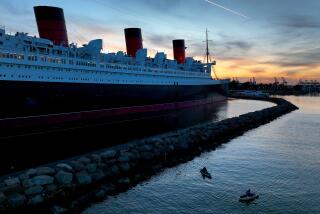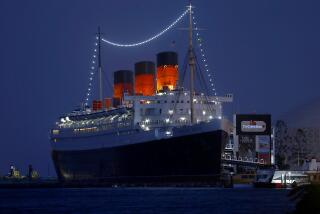Singing the Praises of a Queenly Lady : History: For two people celebrating the Queen Mary’s 59th anniversary, she’s not just a ship. To her designer and one of her builders, she’s a beloved work of art.
- Share via
For many Southern Californians the Queen Mary is just another tourist attraction, a jetty-bound floating hotel in Long Beach Harbor.
But to John Brown, 92, and George Kean, 76, both of Clydebank, Scotland, she is much more. To Brown, who designed her, and Kean, who helped build her, the Queen Mary is their masterpiece, a 1,020-foot-long work of art rendered in wood and rivets and steel.
For Brown and Kean, who had come to Long Beach for ceremonies marking the 59th anniversary of the Queen Mary’s launching, seeing the ship again last weekend after so many decades was like a trip back to another era, to a time when she was the biggest, fastest luxury liner the world had ever seen.
“I must admit I got very emotional when I first saw her,” said Brown, a trim, silver-haired man who as a young naval architect drew up the first plans for the great liner. “No one man designed that ship, she was the product of many hands. But she is the thing of which I am most proud.”
“I hadn’t seen her in 59 years, not since she left the (River) Clyde,” said Kean, who was a teen-ager when he first went to work on the Queen Mary as an apprentice shipwright in the early 1930s. “I must say, seeing her again put tears in my eyes. She looked fine, just fine.”
Brown’s involvement with the Queen Mary began long before the first rivet was installed, long before she even had a name.
In 1926, the young graduate of the naval architecture school at Glasgow University was asked to begin drawing up plans--secretly--for the biggest and fastest transatlantic liner ever built. In that time before commercial air travel, the lucrative Atlantic passenger trade was bitterly contested by most of the world’s great sea powers, and Britain’s dominant Cunard Line was facing increasing competition. She needed a great ship to hold on to her lead.
The Queen Mary would be that ship.
Brown, who worked for the John Brown Shipyard in Clydebank near Glasgow (he was no relation to the shipyard owner) spent the next several years working on the plans. Finally, in 1930, the keel for what was then known as “Job 534” was laid. But the Great Depression intervened and in 1931 construction was halted for more than two years.
When work on the liner began again in 1934, 18-year-old George Kean, a former soap boy at a barber shop next to the shipyard, managed to land a job as an apprentice shipwright, or carpenter. He was one of 15,000 men who worked on the still-unnamed liner as shipwrights, riveters, and in a multitude of other jobs. Kean spent most of his time helping to install the teak decks.
On Sunday, Kean told a story about how the Queen Mary finally got her name. Cunard reportedly had been planning to name her the Victoria--all of Cunard’s great ships had names ending in “ia”--but when a Cunard official asked King George V if they could name the liner after “England’s greatest queen,” the king replied, “Of course, my wife would be delighted.” King George’s wife was Queen Mary.
“I don’t know if it’s true, but that’s my story and I’ll stick by it,” Kean said.
On Sept. 26, 1934, a cold and rainy day, the Queen Mary was finally launched into the River Clyde. Later she was taken to Southampton, her home port, for sea trials. Kean never saw her again--except in newsreels and on television--until last weekend. That was when he, Brown and Ron Winter, 82, an early engineering officer, were invited here by the Queen Mary Foundation, a nonprofit group dedicated to preserving the historic integrity of the ship.
The Queen Mary had cost about 4.5 million British pounds, or about about $22 million in 1934 U.S. dollars, to build.
The Queen Mary went on to make 1,001 Atlantic crossings, and served as a troop transport during World War II. Like most of the men who helped build her, shipwright Kean never sailed aboard her--”I couldn’t afford it,” he said. (First-class fare in the 1930s was more than $500, a considerable sum.)
Brown didn’t sail aboard his creation until the late 1960s, when the Queen Mary was about to be put up for sale. In 1967, after retiring as head of the John Brown Shipyard, Brown finally crossed the Atlantic aboard his masterpiece.
He admits now that he had some reservations when, that same year, he heard that the Queen Mary had been bought by the city of Long Beach for $3.5 million as a tourist attraction. “At the time I thought that perhaps they should just put her out to sea and sink her,” Brown said. “I’ve changed my opinion now.”
Both Brown and Kean--who had never met before they were brought together for the Queen Mary’s 59th anniversary ceremony--say they noticed a few changes in the old liner. Kean cast an artisan’s eye at the teak decks he helped put down 59 years ago and said, “They’ll have to be replaced soon; there’s been too many feet on ‘em.”
But both men still seemed pleased with the ship, and proud of the roles they played in her creation.
Brown, who during the anniversary ceremony presented to the ship the draftsman’s tools he used when drawing up the first plans for the Queen Mary, said:
“There’ll never be another like her.”
More to Read
Sign up for The Wild
We’ll help you find the best places to hike, bike and run, as well as the perfect silent spots for meditation and yoga.
You may occasionally receive promotional content from the Los Angeles Times.






